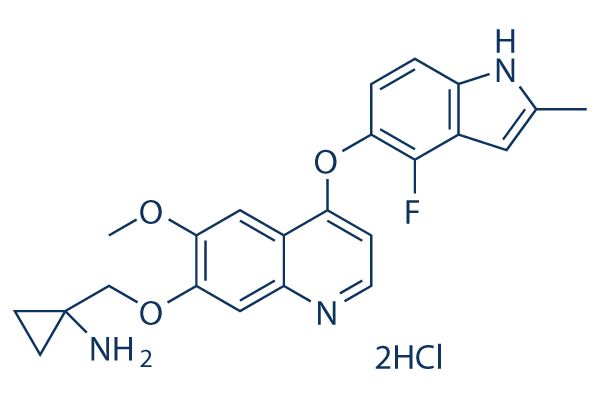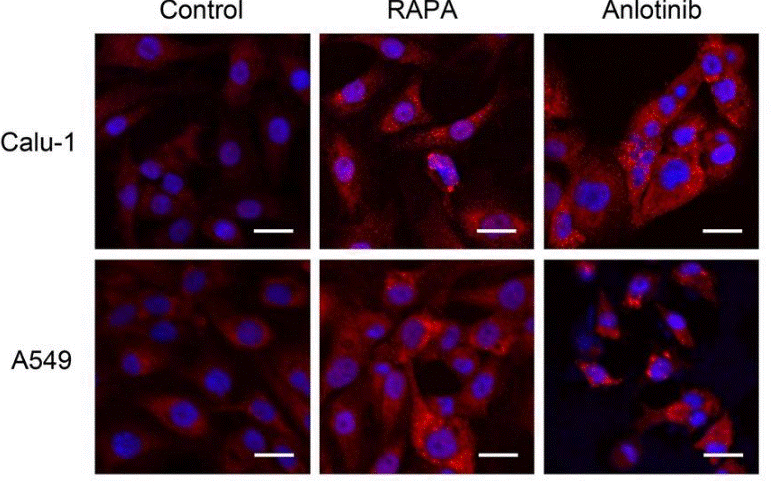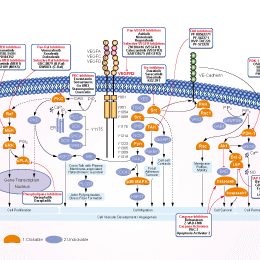
- Bioactive Compounds
- By Signaling Pathways
- PI3K/Akt/mTOR
- Epigenetics
- Methylation
- Immunology & Inflammation
- Protein Tyrosine Kinase
- Angiogenesis
- Apoptosis
- Autophagy
- ER stress & UPR
- JAK/STAT
- MAPK
- Cytoskeletal Signaling
- Cell Cycle
- TGF-beta/Smad
- DNA Damage/DNA Repair
- Compound Libraries
- Popular Compound Libraries
- Customize Library
- Clinical and FDA-approved Related
- Bioactive Compound Libraries
- Inhibitor Related
- Natural Product Related
- Metabolism Related
- Cell Death Related
- By Signaling Pathway
- By Disease
- Anti-infection and Antiviral Related
- Neuronal and Immunology Related
- Fragment and Covalent Related
- FDA-approved Drug Library
- FDA-approved & Passed Phase I Drug Library
- Preclinical/Clinical Compound Library
- Bioactive Compound Library-I
- Bioactive Compound Library-Ⅱ
- Kinase Inhibitor Library
- Express-Pick Library
- Natural Product Library
- Human Endogenous Metabolite Compound Library
- Alkaloid Compound LibraryNew
- Angiogenesis Related compound Library
- Anti-Aging Compound Library
- Anti-alzheimer Disease Compound Library
- Antibiotics compound Library
- Anti-cancer Compound Library
- Anti-cancer Compound Library-Ⅱ
- Anti-cancer Metabolism Compound Library
- Anti-Cardiovascular Disease Compound Library
- Anti-diabetic Compound Library
- Anti-infection Compound Library
- Antioxidant Compound Library
- Anti-parasitic Compound Library
- Antiviral Compound Library
- Apoptosis Compound Library
- Autophagy Compound Library
- Calcium Channel Blocker LibraryNew
- Cambridge Cancer Compound Library
- Carbohydrate Metabolism Compound LibraryNew
- Cell Cycle compound library
- CNS-Penetrant Compound Library
- Covalent Inhibitor Library
- Cytokine Inhibitor LibraryNew
- Cytoskeletal Signaling Pathway Compound Library
- DNA Damage/DNA Repair compound Library
- Drug-like Compound Library
- Endoplasmic Reticulum Stress Compound Library
- Epigenetics Compound Library
- Exosome Secretion Related Compound LibraryNew
- FDA-approved Anticancer Drug LibraryNew
- Ferroptosis Compound Library
- Flavonoid Compound Library
- Fragment Library
- Glutamine Metabolism Compound Library
- Glycolysis Compound Library
- GPCR Compound Library
- Gut Microbial Metabolite Library
- HIF-1 Signaling Pathway Compound Library
- Highly Selective Inhibitor Library
- Histone modification compound library
- HTS Library for Drug Discovery
- Human Hormone Related Compound LibraryNew
- Human Transcription Factor Compound LibraryNew
- Immunology/Inflammation Compound Library
- Inhibitor Library
- Ion Channel Ligand Library
- JAK/STAT compound library
- Lipid Metabolism Compound LibraryNew
- Macrocyclic Compound Library
- MAPK Inhibitor Library
- Medicine Food Homology Compound Library
- Metabolism Compound Library
- Methylation Compound Library
- Mouse Metabolite Compound LibraryNew
- Natural Organic Compound Library
- Neuronal Signaling Compound Library
- NF-κB Signaling Compound Library
- Nucleoside Analogue Library
- Obesity Compound Library
- Oxidative Stress Compound LibraryNew
- Plant Extract Library
- Phenotypic Screening Library
- PI3K/Akt Inhibitor Library
- Protease Inhibitor Library
- Protein-protein Interaction Inhibitor Library
- Pyroptosis Compound Library
- Small Molecule Immuno-Oncology Compound Library
- Mitochondria-Targeted Compound LibraryNew
- Stem Cell Differentiation Compound LibraryNew
- Stem Cell Signaling Compound Library
- Natural Phenol Compound LibraryNew
- Natural Terpenoid Compound LibraryNew
- TGF-beta/Smad compound library
- Traditional Chinese Medicine Library
- Tyrosine Kinase Inhibitor Library
- Ubiquitination Compound Library
-
Cherry Picking
You can personalize your library with chemicals from within Selleck's inventory. Build the right library for your research endeavors by choosing from compounds in all of our available libraries.
Please contact us at info@selleckchem.com to customize your library.
You could select:
- Antibodies
- Bioreagents
- qPCR
- 2x SYBR Green qPCR Master Mix
- 2x SYBR Green qPCR Master Mix(Low ROX)
- 2x SYBR Green qPCR Master Mix(High ROX)
- Protein Assay
- Protein A/G Magnetic Beads for IP
- Anti-Flag magnetic beads
- Anti-Flag Affinity Gel
- Anti-Myc magnetic beads
- Anti-HA magnetic beads
- Poly DYKDDDDK Tag Peptide lyophilized powder
- Protease Inhibitor Cocktail
- Protease Inhibitor Cocktail (EDTA-Free, 100X in DMSO)
- Phosphatase Inhibitor Cocktail (2 Tubes, 100X)
- Cell Biology
- Cell Counting Kit-8 (CCK-8)
- Animal Experiment
- Mouse Direct PCR Kit (For Genotyping)
- New Products
- Contact Us
research use only
Anlotinib (AL3818) dihydrochloride VEGFR inhibitor
Anlotinib (AL3818) is a highly potent and selective VEGFR2 inhibitor with IC50 less than 1 nM. It has broad-spectrum antitumor potential in clinical trials. Please use saline solution rather than PBS for dilutions. PBS may cause precipitation.

Chemical Structure
Molecular Weight: 480.36
Purity & Quality Control
Batch:
Purity:
99.93%
99.93
Related Products
| Related Targets | VEGFR1 VEGFR2 VEGFR3 | Click to Expand |
|---|---|---|
| Related Products | Cediranib (AZD2171) Vatalanib (PTK787) 2HCl Linifanib (ABT-869) SAR131675 Apatinib Apatinib (YN968D1) mesylate Ki8751 ZM 323881 HCl Semaxanib (SU5416) SU5402 Cediranib Maleate Motesanib Diphosphate (AMG-706) Brivanib (BMS-540215) Motesanib (AMG-706) ZM 306416 KRN 633 Telatinib Fruquintinib SKLB1002 Taxifolin (Dihydroquercetin) | Click to Expand |
| Related Compound Libraries | Kinase Inhibitor Library Tyrosine Kinase Inhibitor Library PI3K/Akt Inhibitor Library Cell Cycle compound library Angiogenesis Related compound Library | Click to Expand |
Signaling Pathway
Cell Culture and Working Concentration
| Cell Lines | Assay Type | Concentration | Incubation Time | Formulation | Activity Description | PMID |
|---|---|---|---|---|---|---|
| U-87MG | Function assay | 0.01, 0.1, 1, 10 and 100 μM | 1.5 h | inhibited PDGF-BB-stimulated phosphorylation of PDGFRβ, AKT and ERK in U-87MG cells | 29446853 | |
| Mo7e | Function assay | 0.01, 0.1, 1, 10 and 100 μM | 1.5 h | Anlotinib inhibited SCF‐1‐stimulated phosphorylation of c‐Kit, AKT and ERK in Mo7e cells | 29446853 | |
| HUVEC | Function assay | 0.01, 0.1, 1, 10 and 100 μM | 1.5 h | anlotinib inhibited VEGF‐stimulated intracellular phosphorylation of VEGFR2 in a concentration‐dependent way in HUVEC with a subnanomolar IC50 value | 29446853 | |
| A549 | Cell viability assay | 24, 48 and 72 h | IC50=64.82 μM(t=24 h); IC50=30.34 μM(t=48 h); IC50=17.29 μM(t=72 h) | 30755242 | ||
| NCI-H1975 | Cell viability assay | 8 μg/ml | 24 h | Cell viability was decreased remarkably | 30871526 | |
| Calu-1 | Cell viability assay | 24, 48 and 72 h | IC50=61.23 μM(t=24 h); IC50=36.8 μM(t=48 h); IC50=28.64 μM(t=72 h) | 30755242 | ||
| Click to View More Cell Line Experimental Data | ||||||
Mechanism of Action
| Targets |
|
|---|
In vitro |
||||
| In vitro | Anlotinib occupies the ATP-binding pocket of VEGFR2 tyrosine kinase and shows high selectivity and inhibitory potency (IC 50 <1 nmol/L) for VEGFR2 relative to other tyrosine kinases. Anlotinib inhibits VEGFR2 and VEGFR3 with IC50 values of 0.2 and 0.7 nmol/L, respectively. The inhibitory potency of anlotinib against VEGFR1 is lower, with an IC50 value of 26.9 nmol/L. The IC50 values of anlotinib for inhibition of the PDGFR-related kinases c-Kit and PDGFRβ are 14.8 and 115.0 nmol/L, respectively. Anlotinib has little effect on the activity of other kinases, including c-Met, c-Src, EGFR and HER2, even at a concentration of 2000 nmol/L. Anlotinib inhibits VEGF-induced signaling and cell proliferation in HUVEC with picomolar IC50 values. However, micromolar concentrations of anlotinib are required to inhibit tumor cell proliferation directly in vitro. Anlotinib significantly inhibits HUVEC migration and tube formation; it also inhibits microvessel growth from explants of rat aorta in vitro[1]. | |||
|---|---|---|---|---|
| Kinase Assay | Enzyme-linked immunosorbent assay | |||
| Inhibitory activity of anlotinib against tyrosine kinases was determined using ELISA. Reaction of ATP with tyrosine kinase was initiated in reaction buffer (50 mmol/L HEPES pH 7.4, 50 mmol/L MgCl2, 0.5 mmol/L MnCl2, 0.2 mmol/L Na3VO4, 1 mmol/L DTT) and incubated for 1 hour at 37°C in 96-well plates precoated with 20 μg/mL Poly(Glu,Tyr)4:1. The plate was incubated with PY99 antibody and then with HRP-conjugated anti-mouse IgG. After reaction with o-phenylenediamine solution and then termination with the addition of 2N H2SO4, absorbance was measured at 490 nm using a Synergy H4 Hybrid reader. | ||||
| Cell Research | Cell lines | HUVEC, Mo7e, U-87MG and A431 cells | ||
| Concentrations | 0-10 μM | |||
| Incubation Time | 1.5 h | |||
| Method | Serum-starved HUVEC, Mo7e, U-87MG and A431 cells are treated with different concentrations of test agents for 1.5 h and then stimulated with vascular endothelial growth factor (VEGF; 20 ng/mL), stem cell factor-1 (SCF-1; 2.5 ng/mL), platelet-derived growth factor-BB (PDGF-BB; 10 ng/mL), or epidermal growth factor (EGF; 10 ng/mL) for 10 min, respectively. Cell lysates are probed with the indicated antibodies. |
|||
| Experimental Result Images | Methods | Biomarkers | Images | PMID |
| Western blot | TP53 / Cleaved-caspase 3 / Cleaved PARP Beclin-1 / LC3-I / LC3-II Akt / p-Akt / mTOR / p-mTOR |

|
30139768 | |
| Immunofluorescence | LC3-II |

|
30755242 | |
| Growth inhibition assay | Cell viability |

|
30755242 | |
In Vivo |
||
| In vivo | Anlotinib decreases vascular density in tumor tissue in vivo. Compared with the well-known tyrosine kinase inhibitor sunitinib, once-daily oral dose of anlotinib shows broader and stronger in vivo antitumor efficacy and, in some models, causes tumor regression in nude mice. It is well-tolerated in mice. Anlotinib is efficacious at doses (1.5‐6 mg/kg daily) that are significantly lower than effective doses of other TKI, which require doses of 20‐100 mg/kg to achieve significant inhibition of tumor growth in mice[1]. In vivo, anlotinib has showed broad activity against human tumor xenograft models of the colon (SW-620), ovarian (SK-OV-3), liver (SMMC-7721), renal (Caki-1), glioma (U87MG), and non-small cell lung (Calu-3) during dosing period. In Sprague-Dawley rats and beagle dogs, anlotinib is rapidly absorbed from the gastrointestinal tracks after oral administration. The oral bioavailability is 23-45 % in rats and 47-74 % in dogs. Anlotinib exhibits large volume of distribution in both species. In rats, primary tissues, such as the lung, kidneys, liver, and heart, exhibit significant higher exposure levels to anlotinib compared with that in plasma. The exposure level in the brain is comparable with the corresponding plasma level. In tumor-bearing mice, anlotinib concentrates 2.4-2.6 times in tumor tissue than in plasma. In human, anlotinib exhibits a quite long t1/2 (96 ± 17 h), which appeared to be dose-independent[2]. The terminal half-life of anlotinib in dogs (22.8±11.0 h) is longer than that in rats (5.1±1.6 h). This difference appeares to be mainly associated with an interspecies difference in total plasma clearance (rats, 5.35±1.31 L/h/kg; dogs, 0.40±0.06 L/h/kg). In human plasma, anlotinib is predominantly bound to albumin and lipoproteins, rather than to α1-acid glycoprotein or γ-globulins[3]. | |
|---|---|---|
| Animal Research | Animal Models | human colon cancer SW620 xenograft model(Balb/cA-nude mice, 5-6 weeks old) |
| Dosages | 0.75, 1.5, 3 and 6 mg/kg | |
| Administration | oral | |
| NCT Number | Recruitment | Conditions | Sponsor/Collaborators | Start Date | Phases |
|---|---|---|---|---|---|
| NCT06331169 | Not yet recruiting | Breast Cancer |
Fudan University |
April 1 2024 | Phase 1 |
| NCT06015061 | Recruiting | Pheochromocytoma Metastatic|Ultrasonography|Paraganglioma Malignant|Pheochromocytoma Malignant |
Peking Union Medical College Hospital |
March 1 2023 | -- |
| NCT05816499 | Recruiting | NSCLC Stage IV|NSCLC Stage IIIB|NSCLC Stage IIIC |
Shanghai Chest Hospital|The Affiliated Hospital of Qingdao University|Anhui Provincial Hospital|Zhejiang University |
February 16 2023 | Phase 1|Phase 2 |
| NCT05883085 | Recruiting | Pheochromocytoma|Paraganglioma |
Peking Union Medical College Hospital |
May 1 2022 | Phase 2 |
| NCT05301764 | Recruiting | Soft Tissue Sarcoma |
Lyvgen Biopharma Holdings Limited |
May 25 2022 | Phase 1|Phase 2 |
References |
|
Chemical Information
| Molecular Weight | 480.36 | Formula | C23H22FN3O3.2HCl |
| CAS No. | 1360460-82-7 | SDF | -- |
| Synonyms | N/A | ||
| Smiles | CC1=CC2=C(N1)C=CC(=C2F)OC3=C4C=C(C(=CC4=NC=C3)OCC5(CC5)N)OC.Cl.Cl | ||
Storage and Stability
| Storage (From the date of receipt) | 3 years -20°C powder | ||
|
In vitro |
Water : 96 mg/mL DMSO : 48 mg/mL ( (99.92 mM) Moisture-absorbing DMSO reduces solubility. Please use fresh DMSO.) Ethanol : Insoluble |
Molecular Weight Calculator |
|
In vivo Add solvents to the product individually and in order. |
In vivo Formulation Calculator |
|||||
Preparing Stock Solutions
Molarity Calculator
In vivo Formulation Calculator (Clear solution)
Step 1: Enter information below (Recommended: An additional animal making an allowance for loss during the experiment)
mg/kg
g
μL
Step 2: Enter the in vivo formulation (This is only the calculator, not formulation. Please contact us first if there is no in vivo formulation at the solubility Section.)
% DMSO
%
% Tween 80
% ddH2O
%DMSO
%
Calculation results:
Working concentration: mg/ml;
Method for preparing DMSO master liquid: mg drug pre-dissolved in μL DMSO ( Master liquid concentration mg/mL, Please contact us first if the concentration exceeds the DMSO solubility of the batch of drug. )
Method for preparing in vivo formulation: Take μL DMSO master liquid, next addμL PEG300, mix and clarify, next addμL Tween 80, mix and clarify, next add μL ddH2O, mix and clarify.
Method for preparing in vivo formulation: Take μL DMSO master liquid, next add μL Corn oil, mix and clarify.
Note: 1. Please make sure the liquid is clear before adding the next solvent.
2. Be sure to add the solvent(s) in order. You must ensure that the solution obtained, in the previous addition, is a clear solution before proceeding to add the next solvent. Physical methods such
as vortex, ultrasound or hot water bath can be used to aid dissolving.
Tech Support
Answers to questions you may have can be found in the inhibitor handling instructions. Topics include how to prepare stock solutions, how to store inhibitors, and issues that need special attention for cell-based assays and animal experiments.
Tel: +1-832-582-8158 Ext:3
If you have any other enquiries, please leave a message.
* Indicates a Required Field






































